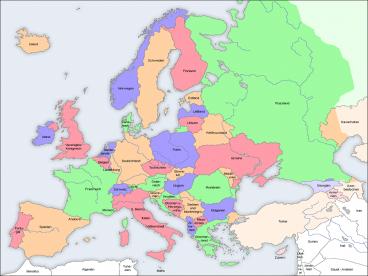Folie 1 - PowerPoint PPT Presentation
1 / 10
Title:
Folie 1
Description:
... new gothic style, through which Hungary came back into fashion for a short time. ... There are no existing documents from the pre-11th century era. ... – PowerPoint PPT presentation
Number of Views:46
Avg rating:3.0/5.0
Title: Folie 1
1
(No Transcript)
2
hungary
literature
culture
art
3
- Info -
literature
culture
art
4
- culture -
Some of the most important preserved monuments of
Hungary are built in the late romanic style. They
are strongly influenced by Western Europe
(Rhoneland, Cologne) e.g. the churches in Zsámbék
and Ják of the 13th century. Out of the gothic
period the Blac church in Brasov (today in
Rumania) out of the 15th century. One of the most
important monuments of this epoc is the Castle of
Count Esterházy in Fertod, whose model was the
castle of Versaille. Mihály Pollack, one of the
master builders of classisicism was born in
Vienna. Miklós Ybl was responsible for the
flourishing renaissance period in Hungary (e.g.
Operahouse in Budapest. Imre Steindl built the
parliamentbuilding (18851902) in Budapest in new
gothic style, through which Hungary came back
into fashion for a short time. Around the turn of
the century many buildings were built in the
Youth-style, e.g. the institute for blind people
in Budapest. In Kecskemét a nice example fort his
style is the Cifra Palota, which was built in
1902 following the plans of Géza Márkus, and
whose facade is adorned with Zsolnay-ceramics. In
the old town houses with inner courtyards and
open hallways are typical. Theyre usually to be
found near the Great Ring (nagykörút). In the
years of communist occupation these houses became
dilapitaed, nowadays alot of substandard
appartements are found in these quarters.
literature
culture
art
5
- Art -
The most famous hungarian artist of the 15th
century was Michele Ongaro. He worked in the
court of Ferrara in Italy. The hungarian artists
of the 17th and 18th century mainly worked
outside of Hungary. In the 19th century national
Historypainting emerged (by artists such as Gyula
Benczúr, Bertalan Székely, Mór Than). Miklós
Barabás, a portraitist, was the first to be
recognized in his own country. Paintings by
Mihály Zichy and Géza Mészöly are especially
influenced by romanticism. At the turn of the
century the artist colony of Nagybánya, founded
by Károly Ferenczy, came to be recognized, with
their unique Naturepainting. ! Die
sozialistisch-realistischen Genre- und
Historienmalerei war in den 1950er und 1960er
Jahren besonders beliebt. Danach kamen
unterschiedliche internationale Strömungen ins
Spiel, hauptsächlich aber die Medienkunst und die
abstrakte und realistische Malerei
(beispielsweise Imre Bak oder Dóra Maurer). Mit
Victor Vasarely, Zsigmond Kemény und László
Moholy-Nagy stammen einige der führenden, im
Ausland arbeitenden Künstler des 20. Jahrhunderts
aus Ungarn. ! Victor Vasarely, Zsigmond Kemény
and László Moholy-Nagy are some of the artists of
the 20th century. István Szonyi, Jeno Barcsay,
László Lakner and Aurél Bernáth. Are famous
today.
literature
culture
art
6
- Literature -
In the earliest times Hungarian language was
written in a runic-like script (although it was
not used for literature purposes in the modern
interpretation). The country switched to the
Latin alphabet after being Christianized under
the reign of Stephen I (10001038). There are no
existing documents from the pre-11th century
era. The oldest written record in Hungarian is a
fragment in the founding document of the Abbey of
Tihany (1055) which contains the words feheruuaru
rea meneh hodu utu rea, "up the military road to
Fehérvár" (referring to the place where the abbey
was built). (This text is probably to be read as
Fehérü váru reá meneü hodu utu reá with today's
spelling and it would sound as a Fehérvárra meno
hadi útra in today's Hungarian.) The rest of
the document was written in Latin. The oldest
complete text is the Funeral Sermon and Prayer
(Halotti beszéd és könyörgés) (11921195), a
translation of a Latin sermon. (See also Funerary
text and the links below.) The oldest poem is the
Old Hungarian Laments of Mary (Ómagyar
Mária-siralom), also a (not very strict)
translation from Latin, from the 13th century. It
is also the oldest surviving Finno-Ugric
poem. Renaissance literature flourished under the
reign of King Matthias (14581490). Janus
Pannonius, although wrote in Latin, counts as one
of the most important persons in Hungarian
literature, being the only significant Hungarian
Humanist poet of the period. The first printing
house was also founded during Matthias' reign, by
András Hess, in Buda. The first book printed in
Hungary was the Chronica Hungarorum. In the 1526
most of Hungary fell under Ottoman occupation,
which date is where the beginning of Middle
Hungarian Period is set, in connection with
various cultural changes. The most important
poets of the period was Bálint Balassi
(15541594) and Miklós Zrínyi (16201664).
Balassi's poetry shows Mediaeval influences, his
poems can be divided into three sections love
poems, war poems and religious poems. Zrínyi's
most significant work, the epic Szigeti
veszedelem ("Peril of Sziget", written in
1648/49) is written in a fashion similar to The
Iliad, and recounts the heroic Battle of
Szigetvár, where his great-grandfather died while
defending the castle of Szigetvár.
literature
culture
art
7
ehain bridge
8
royal castle
9
liberty statue
10
st. matthias church

